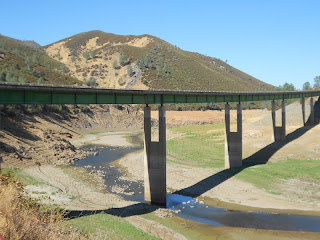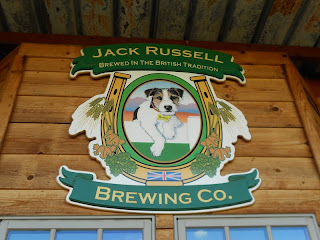Getting there:
We headed on Highway 49 for the town of Jamestown which we had been told was very attractive. After another hairy drive across the Sierra mountains the terrain began to change again, and we crossed the River Merced which was alarmingly low. We keep seeing on TV here about how low US crop yields are this year: bad news for the rest of us with food prices.
Coulterville
It was completely by chance that we came upon this gem of a town. If we hadn't spotted what looked like an interesting hotel we probably would never had stopped as amazingly there was no mention of it in the guide book.
Coulterville in its heyday was a major gold mining and supply centre, and remains full of historic buildings.
It's named after George and Mary Coulter who travelled by covered wagon from Pennsylvania to California in 1849. George was a shrewd business man and quickly realised that the large number of miners looking for gold had to travel over 30 miles to get supplies, so he opened business in a large blue canvas tent over which he conspicuously flew the American flag. The tent became a landmark for the nearly 2,000 miners locally who called the place 'Little Flag'. After gold was discovered in 1852 numbers grew rapidly and the town thrived, changing its name in 1872 to Coulterville.
By this time Coulterville boasted a population of over 5,000 made up of 9 nationalities. There were 25 saloons and 10 hotels scattered around town. By the late 1890s it became a popular stop for Yosemite-bound tourists who came by stagecoach and horseback and stayed overnight. The town/village is very small now with two saloons and one hotel.
- Jeffrey Hotel:
Its 30 inch thick walls, made of rock and clay clinker, date back to 1851.
- Magnolia Room:
This connects to the hotel, and is an authentic early-day saloon.
Real gun slinger doors which Steve burst threw .... well he had been driving for an hour and half around hairy mountain roads with no barriers...
 |
| A group of 'aged' bikers arrived at the same time as us and gave the place added 'ambiance'. |
 |
| It really was gun-slinger territory. |
Look what Sue found...
- Whistling Billy:
- Coulterville Hotel:
The museum relies on volunteers and the lady who showed us round was really knowledgable and helpful. Her family had lived in the town for generations and she could remember much about how the town had been.
 |
| Another 'surry with a fringe on top' |
- Sun Sun Wo Co:
Next door to the store is what is believed to have been a bordello (brothel) for the Chinese community. The local museum has a display of dresses thought to have been worn by the Madam and one of her girls.
We were very interested in the story of the Chinese community of miners as it chimed with what we had seen and learned in Arrowtown in New Zealand. The lady in the museum told us that the Chinese miners here had fared no better when the gold ran out than their counterparts in New Zealand. In Arrowtown this sad period has been explored in an attempt to atone for the past but here in the US there seems to be no such sense of regret and apology. Perhaps, as the lady in the museum said to us by way of explanation, Americans have enough apologies to make to the Native American community so where does it stop?
Jamestown
In the event, when we got to Jamestown we didn't care for it much.
Time to check into our hotel, the Miners Lodge, just outside town. This turned out to be the second consecutive place we had stayed that was owned and run by Indians: this family being from Mumbai (Bombay). We never found out if this was more than a coincidence. It was a very unremarkable sort of place but proudly displayed a newspaper cutting of it having been used by Clint Eastwood in a film he'd made. No sign of him the day we were there though!
Railtown State Historic Park
Railtown 1897 State Historic Park is on the outskirts of Jamestown. We were a bit reluctant to visit it at first, neither of us being particularly interested in trains, but we had a good afternoon there, even if the guide who showed us the Roundhouse ( a semi-circular building for housing and maintaining locomotives)
was a 'man who couldn't be rushed': what was scheduled as a 30 minute tour was 90 minutes and still going strong when we made our excuses and left.
Known as 'The Movie Railroad', Railtown 1897 and its trains have been featured in over 300 feature films (e.g. 'High Noon', 'Back to the Future III' and 'Unforgiven'), TV shows (e.g. 'Little House on the Prairie') and commercials since its first movie in 1919.
Railtown began in 1897 as the Sierra Railroad Company, the brainchild of Thomas Bullock who had owned a failed railroad venture in Arizona. He aimed the Company to bring wood and mining materials to the growing Sacramento and San Francisco areas. It had a chequered business history until the 1970s when it was turned into an excursion train theme park. Unfortunately, its future is in the balance at the moment with severe cut-backs in State and other funding.
 |
| Steve 'getting ready ' for the tour. |
 |
The next train was designed for bumpy tracks you can see the drive piston on one side only and also flexible joints so the undercarriage adusted to the height of the rails. The train was privately owned but had been left in the round house for thirty years after the owner died. The inheritors want it back but will not pay the outstanding rent. Hopefully one day it will be resolved...
This one was specially built to impress investors.
 |
 |
| Trains like these where you could stand outside between carriages, and step down off the train outside, were never built in the UK. |
 |
| These seats could be flipped so that the passenger was always sitting facing the engine. |
Click on the video to see the belt driven machine shop. The belt is pulled from the idle pulley to the driven pulley by a lever to start a particular machine.
ww
Columbia State Historic Park
This was just like a 'wild-west' Black Country Museum'! The tourist information says it is staffed by 'knowledgeable docents' (people dressed-up to look authentic to you and me) but, sadly they were few and far between when we visited, perhaps because it was Monday. We had no trouble wandering down Main Street on our own, though.
 |
| You could get a stagecoach (pony express) at Wells Fargo....... |
 |
| ........or have the gold you'd found weighed and deposited. |
 |
| Most of the sweets in the sweet shop are made on site. |
 |
| You can just picture the judge presiding. |
 |
| This is a horse-drawn hearse. |
 |
| Another 'surry with a fringe on top' |
 |
| No amount of detailed explanation by Steve will make Sue any the wiser about engines.......but then, he's no great shakes on History! |
 |
| We were the only ones having coffee in this 'Victorian Teashop', surrounded by tea being poured from silver teapots with tea-cosies. The sandwiches were American-sized and definitely not cucumber! |
 |
| You could even try your luck panning for gold. |
Sonora, California
Don't ever come here unless you have nerves of steel when trying to drive around the place.
 |
| If only......but it was only a cardboard cut out. |
 |
| Did they mean us??? |
Home to a functioning gold mine, we only passed through quickly, but we did see something that grabbed our interest.
Placerville
Gold was discovered here in 1848 and the area was soon crawling with gold seekers. But not everyone was successful in finding gold and many turned to easier ways (murders and robberies) to get rich. By 1849 frontier justice, i.e. letting the accused swing from the end of a rope from a tall tree, was the accepted solution.
At Dry Diggins, one of the many makeshift camps that had sprung up, there was a giant white oak and it was here that the first such hanging took place. The settlement soon became known as Hangtown and by 1854 it was the third largest settlement in the fledgling state of California. It was decided in that year that a less morbid, though equally colourful, name of Placerville (in reference to 'Placer' or surface mining) would be preferable.
Apple Hill
Just outside Placerville is a major fruit-growing area. We drove along the Apple Hill Scenic Route, sampling as we went.
The road is lined with orchards......
.....owned by different families and growers.
And they don't just grow fruit.
There's no end to what you can do with an apple, though.
Who could resist?
The 'traditional apple' and the 'sour cream apple' pies were delicious here, even if the venue wasn't too alluring.....
.......and the apple donuts (in a much prettier setting) were ace.
www.applehill.com



































1 comment:
I spy pumkins... I have seen loads of them here too- not the normal orange kind though.
Post a Comment